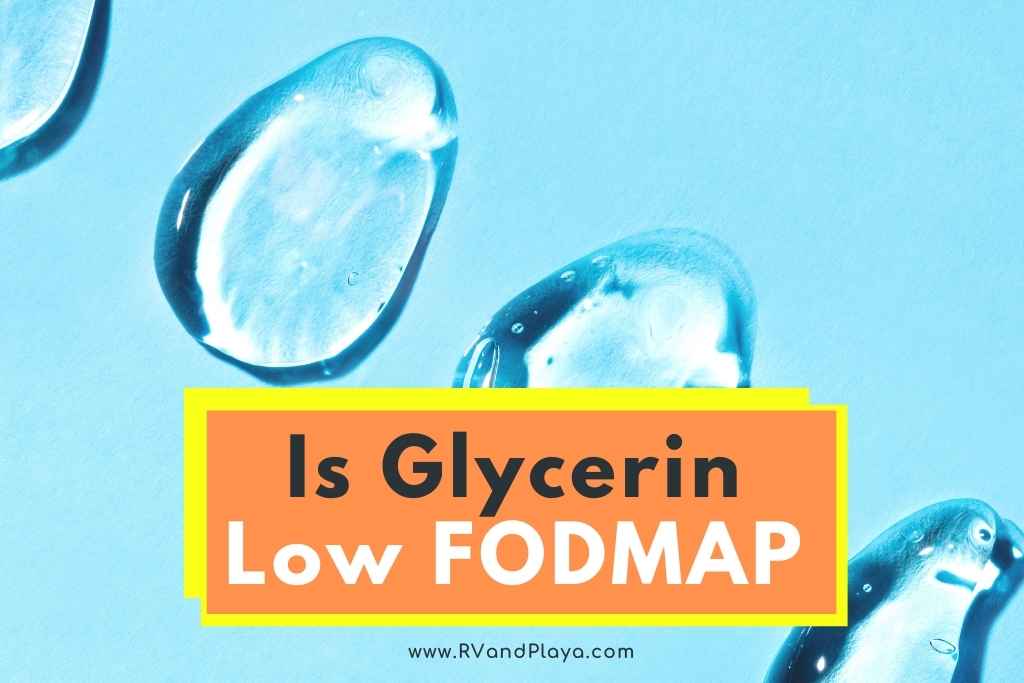If you are considering a low-FODMAP diet, whether your doctor has prescribed it or you are just considering it yourself, you are probably overwhelmed by just what foods are considered low- or high-FODMAP. What about things you wouldn’t normally consider, like glycerin?
So, is glycerin low-FODMAP? Well, it actually doesn’t matter. It is not necessary to exclude glycerin as part of a low-FODMAP diet because it is so small that it actually never reaches the large intestine. It is completely absorbed in the small intestine, meaning that it does not act as a FODMAP.
The rest of this article is going to discuss the low-FODMAP diet, what foods are considered low-FODMAP, and just why you might go on this diet as part of an elimination process.
Table of Contents
Is glycerin low-FODMAP?
While glycerin is not technically a FODMAP at all, if it helps you, you can consider it low-FODMAP. This is because it is not necessary to eliminate glycerin when you are participating on a low-FODMAP diet.
Glycerin is so tiny that it is entirely absorbed in your small intestine before ever reaching the large intestine. So, it does not act as a FODMAP.
What are FODMAPs?
“FODMAP” is an acronym which stands for “Fermentable Oligosaccharides, Disaccharides, Monosaccharides and Polyols.” This is a certain type of carbohydrates referred to as fermentable short-chain carbohydrates. These carbs are often more difficult for people to digest.
- Fermentable carbohydrates are any foods that your gut bacteria converts to gases during the process of fermentation.
- Oligosaccharides are also known as prebiotics. These are soluble plant fibers which feed the bacteria in your fut.
- Disaccharides include lactose, a fermentable sugar which many people are sensitive to.
- Monosaccharides include fructose, the fermentable sugar in fruit.
- Polyols are sugar alcohols, which are often used as artificial sweeteners. They can also be found in some fruits.
Are FODMAPs bad?
FODMAPs are not inherently bad! They are just more difficult for many people to digest since they cannot be broken down and absorbed in your small intestine.
Since they must pass to your large intestine, your small intestine draws in more water to help in moving the FODMAPs there.
Then, the bacteria in your colon ferment the FODMAPs. This process creates both fatty acids and gases in your gut.
Read also: Are Kind Bars Low Fodmap? (The Truth!)
What is a low-FODMAP diet?
A low-FODMAP diet involves reducing FODMAP carbohydrates. Basically, you will try to completely eliminate or severely reduce carbohydrates which fall into the FODMAP category. This diet is often prescribed as what is called an elimination diet, where you eliminate and then slowly introduce food triggers to find out what is triggering your gastrointestinal disorder, like IBS (irritable bowel syndrome).
Why should I go on a low-FODMAP diet?
Like we mentioned in the previous section, the low-FODMAP diet is often prescribed by doctors as a means of discovering what is triggering various gastrointestinal disorders.
If your doctor advises you to go on a low-FODMAP diet, that is a great reason to do so.
Some people may also choose to go on a low-FODMAP diet without being prescribed it by a doctor. In these cases, we still always recommend speaking to a medical professional before starting a new diet such as this one.
However, it is certainly possible to go on a low-FODMAP diet on your own. If you suspect that certain foods are triggering gastrointestinal upset, then a temporary low-FODMAP elimination diet may be just what you need to figure out what is causing your issues.
Read also: Is Dark Chocolate Low Fodmap (IBS, Lindt, Hershey, Dove, Cocoa Powder)
What foods are low-FODMAP?
There is a long list of low-FODMAP foods. We will list some of them here as a starting point, per a graphic from the Cleveland Clinic.
- Vegetables
- Eggplant
- Green Beans
- Bell Pepper
- Carrots
- Cucumber
- Fruits
- Cantaloupe
- Grapes
- Kiwi
- Orange
- Pineapple
- Dairy and alternatives
- Almond milk
- Feta cheese
- Lactose-free milk
- Soy milk
- Hard cheeses
- Protein
- Eggs
- Firm tofu
- Meats
- Tempeh
- Breads and cereals
- Corn flakes
- Oats
- Rice cakes (plain)
- Wheat/rye/barley free breads
- Sugars
- Dark chocolate
- Maple syrup
- Table sugar
- Nuts and seeds
- Macadamia nuts
- Peanuts
- Pumpkin seeds
- Walnuts
What foods are high-FODMAP?
Again, there is a long list of high-FODMAP foods. However, we will list some of them here to help you get started on your low-FODMAP journey. The foods on this list are ones to avoid while participating on a low-FODMAP diet.
- Vegetables
- Artichoke
- Asparagus
- Cauliflower
- Garlic
- Green peas
- Mushrooms
- Onion
- Fruits
- Apples
- Cherries
- Dried fruit
- Mango
- Peaches
- Pears
- Watermelon
- Dairy and alternatives
- Milk
- Ice cream
- Condensed milk
- Yogurt
- Protein
- Legumes
- Processed meats
- Breads and cereals
- Wheat/rye/barley-based breads
- Breakfast cereals
- Sugars
- Honey
- High fructose corn syrup
- Nuts and seeds
- Cashews
- Pistachios
How long should I stay on a low-FODMAP diet?
A low-FODMAP diet is not intended to be permanent. You should only stay on it for long enough to fully eliminate everything you need to.
Most doctors recommend at least two weeks, but no longer than six weeks for the first phase, known as the elimination phase.
Once you begin reintroducing the foods you have eliminated, this phase may last about eight weeks. It could be slightly longer or shorter though, depending on the individual.
You introduce a high-FODMAP food from each category one at a time.
This may take a while since you need to space out each reintroduced food to make sure you are getting the effects of one food at a time.
Conclusion
So, is glycerin low-FODMAP? Well, technically, glycerin is not a FODMAP at all! So, you do not have to worry about cutting it out when you are participating in a low-FODMAP diet.
Many people start low-FODMAP diets as an elimination process to figure out which foods are triggering gastrointestinal upset.
It is a slow process of cutting out low-FODMAP foods, then reintroducing them one at a time over a period of several weeks.
When considering starting a low-FODMAP diet, you should always first consult your doctor or another healthcare professional. You want to make sure that you are conducting the process of elimination and reintroduction safely and healthily. Good luck on your low-FODMAP journey!
Here are some of my favorite services, products, and Stores
There are affiliate links, so if you do decide to use any of them, I´ll earn a small commission. But in all honesty, these are the exact what I use and recommend to everyone, even my own family.
To see all my of most up-to-date recommendations, check out this resource that I made for you!
+ Products & Services
+ Convenience Stores
+ Save Thousands of Dollars
References
https://foodinsight.org/what-is-glycerin/
https://my.clevelandclinic.org/health/treatments/22466-low-fodmap-diet
Recent Posts
Is Dark Chocolate Low Fodmap (IBS, Lindt, Hershey, Dove, Cocoa Powder)
Have you ever asked yourself or your friend if dark chocolate like Lindt, Dove or Hershey are low Fodmap? Well, you are at the perfect place to find the answer to such a question. The Low FODMAP...
Have you ever asked yourself or your friend if Pectin is low Fodmap? Well, you are at the perfect place to find the answer to such a question. Pectin is a well-known plant-based fiber that offers...


